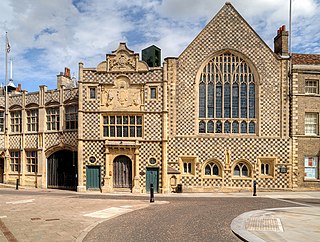Related Research Articles

An autobiography, sometimes informally called an autobio, is a self-written biography of one's own life.
Year 1373 (MCCCLXXIII) was a common year starting on Saturday of the Julian calendar.

Joan Beaufort was the youngest of the four legitimised children and only daughter of John of Gaunt, 1st Duke of Lancaster, by his mistress, later wife, Katherine de Roet. She married Ralph de Neville, 1st Earl of Westmorland and in her widowhood became a powerful landowner in the north of England.
This article contains information about the literary events and publications of 1501.
Margery Kempe was an English Christian mystic, known for writing through dictation The Book of Margery Kempe, a work considered by some to be the first autobiography in the English language. Her book chronicles her domestic tribulations, her extensive pilgrimages to holy sites in Europe and the Holy Land, as well as her mystical conversations with God. She is honoured in the Anglican Communion, but has not been canonised as a Catholic saint.

King's Lynn and West Norfolk is a local government district with borough status in Norfolk, England. Its council is based in the town of King's Lynn. The district also includes the towns of Downham Market and Hunstanton, along with numerous villages and surrounding rural areas. The population of the district at the 2021 census was 154,325.

The Book of Margery Kempe is a medieval text attributed to Margery Kempe, an English Christian mystic and pilgrim who lived at the turn of the fifteenth century. It details Kempe's life, her travels, her accounts of divine revelation including her visions of interacting with the Trinity, particularly Jesus, as well as other biblical figures. These interactions take place through a strong, mental connection forged between Kempe and said biblical figures. The book is also notable for her claiming to be present at key biblical events such as the Nativity, shown in chapter six of Book I, and the Crucifixion.
Alan of Lynn, or Alanus de Lynna, was a famous English theologian of the first half of the fifteenth century.

Charles Eamer Kempe was a British Victorian era designer and manufacturer of stained glass. His studios produced over 4,000 windows and also designs for altars and altar frontals, furniture and furnishings, lychgates and memorials that helped to define a later nineteenth-century Anglican style. The list of English cathedrals containing examples of his work includes: Chester, Gloucester, Hereford, Lichfield, Wells, Winchester and York. Kempe's networks of patrons and influence stretched from the Royal Family and the Church of England hierarchy to the literary and artistic beau monde.
Kempe may refer to:
George Gordon Coulton was a British historian, known for numerous works on medieval history. He was known also as a keen controversialist.
Events from the 1430s in England.

Hope Emily Allen (1883–1960), was an American medievalist who is best known for her research on the 14th-century English mystic Richard Rolle and for her discovery of a manuscript of the Book of Margery Kempe.
Anthony Bale is an English medievalist.
Margery Baxter was an outspoken and heretical Lollard from Martham, England. She was brought to trial twice and flogged at church.
Robert Brunham was a Member of Parliament for Bishop's Lynn in Norfolk, England, in 1402 and 1417.

King's Lynn Guildhall, more fully referred to as the Guildhall of the Holy and Undivided Trinity, is a municipal building in Saturday Market Place in King's Lynn, Norfolk. It is a Grade I listed building. The building was substantially extended in 1895, with the whole complex now generally known as King's Lynn Town Hall, with the 1895 extension being separately listed at Grade II. It is the usual meeting place of King's Lynn and West Norfolk Borough Council.

Richard Caister was an English priest and poet in the late 14th and early 15th centuries, and was the confessor to the English mystic Margery Kempe. After his death in 1420 his burial place in Norwich became a pilgrimage site.
Margery Kempe is a 1994 novel by New Narrative founding member Robert Glück. It is a retelling of Margery Kempe's purported writing, The Book of Margery Kempe, through a narrator named Bob who is in love with a man named L. It was republished in 2020 by New York Review Books.
Robert Brunham may refer to:
References
- ↑ Arnold, John; Lewis, Katherine J. (2004). A Companion to the Book of Margery Kempe. ISBN 9781843840305.